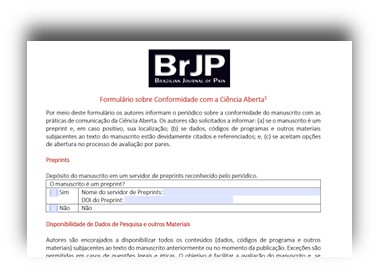|
|
-
Anamaria Siriani de Oliveira, University of São Paulo (USP-RP), Ribeirão Preto, SP, Brazil, Orcid: 0000-0001-5854-0016, Lattes: 0518357370991372, email: siriani@fmrp.usp.br
-
Anita Perpetua Carvalho Rocha de Castro, Federal University of Bahia (UFBA), Salvador, BA, Brazil Orcid: 0000-0002-2957-6770, Lattes: 2863282043928410, e-mail: anitaperpetuacrc@yahoo.com.br
-
Caren Serra Bavaresco, Lutheran University of Brazil (Ulbra), Canoas, RS, Bra-zil, Orcid 0000-0002-0730-3632, Lattes: 2237714828297776, email: c_bavaresco@yahoo.com.br
-
Célia Maria de Oliveira, Federal University of Minas Gerais, Belo Horizonte, MG, Brazil, Orcid: 0000-0002-1937-7364, Lattes: 9391711154551929, email: cmariol@terra.com.br
-
Deyse Borges Machado, Universidade do Estado de Santa Catarina UDESC), Florianópolis, Brasil, Orcid: https://orcid.org/0000-0002-4305-4952, Lattes: http://lattes.cnpq.br/7949821862630834, email: deyse.Borges@udesc.br
-
Durval Campos Kraychete, Federal University of Bahia (UFBA), Salvador, BA, Brazil, Orcid: 0000-0001-6561-6584, Lattes: 6008595426904260, email: dkt@terra.com.br
-
Eduardo Grossmann, Federal University of Rio Grande do Sul (UFRS), Porto Alegre, RS, Brazil, Orcid: 0000-0002-1238-1707, Lattes: 4470378345964718, email: edugdor@gmail.com
-
Érica Brandão de Moraes, School of Nursing at the Fluminense Federal Univer-sity, (UFF), Rio de Janeiro, RJ, Brazil, Orcid: 0000-0003-3052-158X, Lattes: 2265220151524135, email: enfermeira_erica@yahoo.com.br
-
Henrique Ballassini Abdalla, Leopoldo Mandic College (SLMANDIC), Campinas, SP, Brazil, Orcid: 0000-0002-7517-2830, Lattes: 1401215034453544, email: henrique.abdalla@slmandic.edu.br
-
Irimar de Paula Posso, University of São Paulo (USP), São Paulo, SP, Brazil, Orcid: 0000-0003-0337-2531, Lattes: 5789900900585872, email: irimarpposso@gmail.com
-
Isabela Freire Azevedo-Santos, Federal University of Sergipe (UFS), Aracajú, SE, Brazil, Orcid: 0000-0001-8836-8640, Lattes: 3685635024799188, email: ebelaafs@hotmail.com
-
Jamir João Sardá Júnior, Universidade do Vale do Itajaí (Univali), Itajái,SC, Bra-zil, Orcid 0000-0001-9580-8288, Lattes: 6152374334604475, email: jamirsarda@hotmail.com
-
João Batista Santos Garcia, Federal University of Maranhão (UFMA), São Luiz, MA, Brazil, Orcid: 0000-0002-3597-6471, Lattes: 0424234103760462, Email: jbgarcia@uol.com.br
-
Josenilia Maria Alves Gomes,Walter Cantidio University (HUWC), Fortaleza, CE, Brazil, Orcid: 0000-0003-1031-9472, Lattes: 78133384727225202, Email: gomes.josenilia@gmail.com
-
Josie Resende Torres da Silva, Federal University of Alfenas (UNIFAL), Alfenas, MG, Brazil, Orcid: 0000-0002-6679-2675, Lattes: 2678112119789338, Email: josie.resende@unifal-mg.edu.br
-
Katia Nunes Sá, Escola Bahiana de Medicina e Saúde Pública (EBMSP), Salva-dor, BA, Brasil, Orcid: https://orcid.org/0000-0002-0255-4379, Lattes: http://lattes.cnpq.br/4313045041004715, email: katia.sa@gmail.com
-
Levi Higino Jales Júnior, Natal, RN Brasil, Orcid: https://orcid.org/0009-0008-0895-8041, Lattes: http://lattes.cnpq.br/3833558779689434, email: levijales@hotmail.com
-
Lia Rachel Chaves do Amaral Pelloso, Federal University of Mato Grosso (UFMT), Cuiabá, MT, Brazil, Orcid: 0000-0001-9594-9371, Lattes: 1267225376308387, email: liacpelloso@gmail.com
-
Luci Mara França Correia, Post-Graduate Program at Einstein Faculty (HIAE), Curitiba, PR, Brazil, Orcid: 0000-0002-4977-255X, Lattes: 8878925882317970, Email: draluci.odonto@gmail.com
-
Luciana Buin, Universidade Federal de São Carlos (UFSCAR), São Carlos, SP Brasil Orcid https://orcid.org/0000-0002-1824-5749, Lattes http://lattes.cnpq.br/0932365422007861, email: dralucianabuin@gmail.com
-
Marcelo Lourenço da Silva, Federal University of Alfenas (UNIFAL), Alfenas, MG, Brazil, Orcid: 0000-0003-2319-9692, Lattes: 3885164141313284, email: lourencoms@uol.com.br
-
Maria Belén Salazar Posso, Christian University Foundation (UniFUNVIC), Pindamonhangaba, SP, Brazil, Orcid: 0000-0003-3221-6124, Lattes: 4644641106395490, Email: mbelen@terra.com.br
-
Mariana Arias Avila, Federal University of São Carlos (UFSCar), São Carlos, SP, Brazil, Orcid: 0000-0002-5081-5326, Lattes: 5905617922199364, Email: m.avila@ufscar.br
-
Mirlane Guimarães de Melo Cardoso, Federal University of Amazonas (UFAM), Manaus, AM, Brazil, Orcid: 0000-0001-9739-8235, Lattes: 1663863759459785, Email: mirlane.cardoso@uol.com.br
-
Oscar Cesar Pires, University of Taubaté (UNITAU), Taubaté, SP, Brazil, Orcid: 0000-0002-7033-0764, Lattes: 2929971233764932, Email: oscarpires50@gmail.com
-
Rafael Krasic Alaiti, University of São Paulo (USP), São Paulo, SP, Brazil, Orcid: 0000-0003-1830-7011, Lattes: 2213351462207411, Email: rafael.alaiti@gmail.com
-
Robson Emiliano José de Freitas. Hospital Estadual de Urgências de Anápolis Dr. Henrique Santillo (HEANA), Anápolis, GO, Brasil, Orcid: https://orcid.org/0000-0001-9038-8480, Lattes: http://lattes.cnpq.br/7027192186275832, Email: robsonemiliano@hotmail.com
-
Telma Regina Mariotto Zakka, University of São Paulo (USP), São Paulo, SP, Brazil, Orcid: 0000-0002-3222-2244, Lattes: 7210747586447129, Email: trmzakka@gmail.com
-
Thais Cristina Chaves, Federal University of São Carlos (UFSCar), São Carlos, SP, Brazil, Orcid: 0000-0002-6222-4961, Lattes: 6332531515878207, Email: chavestc@fmrp.usp.br
-
Thiago Abner dos Santos Sousa, Universidade Tiradentes (UNIT): Aracaju, SE, Brasil, ORCID https://orcid.org/0000-0001-9653-3116, email: tass.abner@gmail.com
-
Thiago Medina Brazoloto, Cidade de São Paulo University (UNICID), São Paulo, SP, Brazil, Orcid: 0000-0003-4297-3241, Lattes: 7245353593408839, Email: thibrazoloto@yahoo.com.br
-
Vania Maria de Araújo Giaretta, University of Taubaté (UNITAU), Taubaté, SP, Brazil, Orcid: 0000-0003-4231-5054, Lattes: 4171286622427592, Email: vania_giaretta@yahoo.com.br
-
Walter Lisboa Oliveira, Federal University of Sergipe (UFS), Aracajú, SE, Brazil, Orcid: 0000-0001-5798-6737, Lattes: 0512185167681269, Email: walterlisboa@rocketmail.com
|
|

